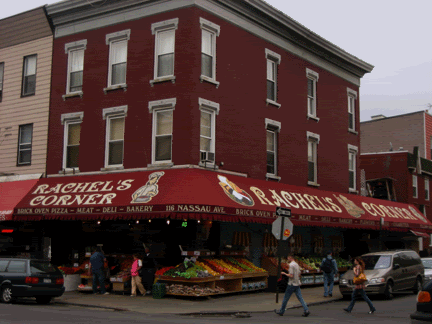 ONE OF GREENPOINT'S greatest establishments is neither a bar nor a restaurant, though it does suspiciously advertise pizza on its awning which is a product I have never actually known it to sell. Curious. Rachel's Corner, located at the corner of Nassau Avenue and Eckford Street, is a 24-hour corner store well-stocked with fresh fruits and veggies, necessary Polish goods, breads, cheeses, pickles, and healthy things as such you can never seem to find them at 3:00 a.m.
ONE OF GREENPOINT'S greatest establishments is neither a bar nor a restaurant, though it does suspiciously advertise pizza on its awning which is a product I have never actually known it to sell. Curious. Rachel's Corner, located at the corner of Nassau Avenue and Eckford Street, is a 24-hour corner store well-stocked with fresh fruits and veggies, necessary Polish goods, breads, cheeses, pickles, and healthy things as such you can never seem to find them at 3:00 a.m.That said, this post could probably also be called "How to Not Make Turkish Coffee." But I'm getting ahead of myself.
Some time ago, Mint and I wandered into Rachel's in search of assorted breakfast foods. We asked the man behind the cashier counter for a bag of the coffee that was perched behind him. He happily obliged, then added (here it comes):

"Have you ever tried Turkish coffee?"
Of course, we had not. He informed us it was slightly sweeter than regular coffee but very delicious. As Mint and I will apparently do anything a kind man behind the counter of a grocery store tells us to do late at night, we agreed to try some. Our now-friend's face beamed. We imagined it was partly his Turkish pride showing through, but also perhaps his shock at having convinced the two of us to buy Turkish coffee simply by mentioning it, cursing inside, and probably wishing he had told us to by the $20 corked bottle of Belgian beer in the back cooler.
We took home our can of finely-ground Royal türk kahvesi, and gave it a shot the next morning. Indeed, it was sweeter than regular coffee but very delicious. Our friend was absolutely right. No masters of Turkish culinary customs, the instructions as printed on the label:
"Turkish coffee is traditionally prepared in a cezve, a small long-handled pot. Place on a low source of heat with one heaped teaspoon of coffee per cupfull of water and add sugar to taste. Heat slowly, stirring gently until the sugar dissolves. When the coffee begins to froth, remove it from the heat. Pour a little of the froth into each cup and return it to the source of heat. Allow the coffee to rise once more, without it reaching boiling-point and serve it in the cup. Be careful not to stir after serving as this will disturb the sediment, leaving a gritty taste.
Having no cezve in our home, we use what we imagine is an appropriate substitute--a saucepan. Well, actually, I'm sure this is absolutely the wrong thing to do, but it suffices to make a decent cup, comparing relatively well to the few cups I've had while dining out.
Add very little sugar at first until you know how sweet the coffee will turn out, and if you do add sugar you should do so during the heating stage as the last sentence of the instructions really is the most important, "Do not stir after serving." Finely-ground as they are, all of the grinds do not dissolve but do settle to the bottom of your cup. Let them rest. Drink happy.


4 comments:
Fascinating! Pour me up a cup o' that joe! I would also like to point out that the awning above Rachel's Garden (pictured) reads quite clearly "Rachel's Corner," which is perhaps not all that important since you listed the address....But what is important: where is that mysterious pizza?! Do you think it is a marketing scheme to draw stumbling late night foot traffic?
i don't think i even know what a sieve looks like... your description made it sound like a regular pot. though i'm probably totall wrong.
Greenpoint is home to a wonderful assortment of natural food shops. The Natural Garden is one of them. The Garden is another (and quite possibly the finest) of the bunch. But it is and always has been Rachel's Corner, not "Garden", open 24-hours a day, 365 days a year. Thanks, Rox, for being able to, you know, read and point that out.
Correction:
I had too tried turkish coffee!
I had just never made it at home and wouldn't have had a clue how to.
P.S. Sometimes I just drink the grinds... still delicious! ....(?)
Post a Comment